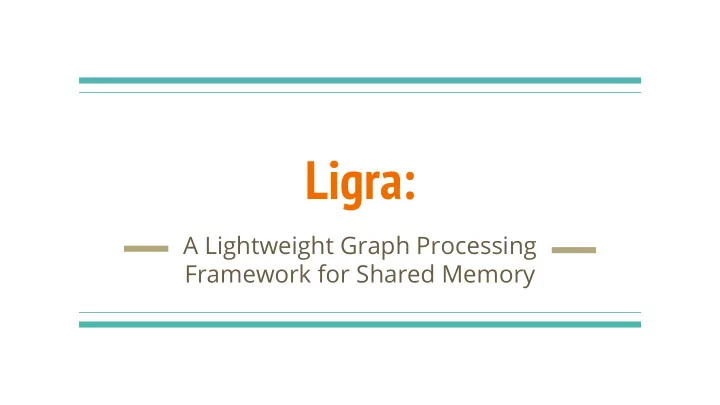

Ligra: A Lightweight Graph Processing Framework for Shared Memory
What’s it hoping to achieve? 1. A simple, concise framework 2. High-performance for shared-memory machines
Why? → An abundance of graph processing applications Problems with other, contemporary, graph processing applications: 1. Focus on the distributed case which is often a. less efficient per core, per dollar, per watt, etc. b. more complex c. examples: Boost Graph Library, Pregel, Pegasus, PowerGraph, Knowledge Discovery Toolkit
Relevant Work: Beamer et al’s fast, hybrid BFS implementation for shared memory 1. Combines a : a. top-down approach ← small frontier b. bottom-up approach ← dense frontiers
Relevant Work: Beamer et al’s fast, hybrid BFS implementation for shared memory 1. Combines a : a. top-down approach ← small frontier b. bottom-up approach ← dense frontiers
Extends Beamer et al’s idea of a Ligra hybrid system to more graphing applications in order to create a lightweight framework for shared A new framework based on memory. Beamer et al’s work
A novel framework Datatypes: 1. G = (V, E) (or G = (V, E, w(E)) 2. vertexSubsets : (U ⊆ V) Functions: 1. vertexMap (U : vertexSubset, F : vertex → bool) : vertexSubset 2. edgeMap (G : graph, U : vertexSubset, F : (vertex x vertex) → bool, C : vertex → bool) : vertexSubset)
Ligra: Hybridization SPARSE: DENSE: → vertices: [0,2,3] or [3,2,0] → vertices : [1,0,1,1,0,0,0,0] → edgeMapSparse → edgeMapDense F(u,ngh) ∀ ngh ∈ neighbours F(ngh,v) ∀ ngh ∈ neighbours ● ● (u) (v) where v ∈ U ∝ |U| + ∑ outdegrees(U) ∝ d|V| ● ● → Switch on |U| + ∑ outdegrees(U) > |E|/20
Ligra: Graph Representation 4 3 in-edges: 4 ... 6 7 3 5 ... (out-edges similarly) Vertex: 3 indegree: 3 outdegree: 5
An Example: BFS Parents = {-1, …, -1} procedure Update(s,d) return (CAS(&Parents[d],-1,s)) procedure Cond(i) return (Parents[i] == -1) procedure BFS(G,r) Parents[r] = r Frontier = {r} while (size(Frontier) != 0) do Frontier = edgeMap(G,Frontier,Update,Cond)
An Example: Connected Components
Algorithms: 1. Bellman-Ford 2. PageRank Evaluation & 3. CC, Graph Radii 4. Betweenness Centrality Experiments 5. Breadth-First Search Datasets: 1. 3D-grid 2. random-local 3. rMat24, rMat27 4. Twitter, Yahoo
10-39x speedup from using Ligra on a range of algorithms
Comparative Evaluation 1. Betweeness Centrality a. KDT: can traverse ~ ⅕ the number of edges as Ligra but on a graph that is smaller b. problem : KDT uses a batch processing system 2. PageRank a. GPS : running time of 1.44 min/iteration whereas Ligra: takes 20sec/iteration on a larger graph b. Powergraph : running time of 3.6 sec/iterations vs Ligra : 2.91 sec/iteration 3. Connected-Components a. Pegasus : running time of 10min/6iterations vs Ligra : 10 seconds/6iterations
Problems with Evaluation 1. Comparing similar graphs on similar problems 2. The dramatic improvements are a bit suspect -- XStream paper 3. Is improvement based on clever use of a poorly implemented language (e. g. the authors know lots about the programming language -- but what about the average user)?
Strengths & Weaknesses Strengths: Weaknesses: simple idea/easy to use ● Narrow optimisation ● can get impressive speedups ● Inconsistent evaluation ● Are the assumptions valid? ●
Take-away 1. We can use a hybridization method for some optimisations 2. A focus on shared-memory
Recommend
More recommend